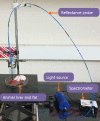Non-invasive real-time assessment of hepatic macrovesicular steatosis in liver donors: Hypothesis, design and proof-of-concept study
- PMID: 34786162
- PMCID: PMC8568585
- DOI: 10.4254/wjh.v13.i10.1208
Non-invasive real-time assessment of hepatic macrovesicular steatosis in liver donors: Hypothesis, design and proof-of-concept study
Abstract
Macrovesicular Steatosis (MS) is an independent risk factor for adverse post-liver transplant (LT) outcomes. The degree of MS is intimately related to the viability of the liver graft, which in turn is crucial to the success of the operation. An ideal liver graft should have no MS and most centres would find it unacceptable to use a donor liver with severe MS for LT. While a formal liver biopsy is the gold-standard diagnostic test for MS, given the logistical and time constraints it is not universally feasible. Other tests like a frozen section biopsy are plagued by issues of fallibility with reporting and sampling bias making them inferior to a liver biopsy. Hence, the development of an accurate, non-invasive, easy-to-use, handheld, real-time device for quantification of MS would fill this lacuna in the deceased donor selection process. We present the hypothesis, design and proof-of-concept of a study, which aims to standardise and determine the feasibility and accuracy of a novel handheld device applying the principle of diffuse reflectance spectroscopy for real-time quantification of MS.
Keywords: Deceased donors; Diffuse reflectance spectroscopy; Liver transplantation; Macrovesicular steatosis; Real-time devices.
©The Author(s) 2021. Published by Baishideng Publishing Group Inc. All rights reserved.
Conflict of interest statement
Conflict-of-interest statement: The above doctors have no conflicts of interest or financial ties to disclose.
Figures




Similar articles
-
Point-of-care device for the noninvasive assessment of hepatic macrosteatosis in liver donors.J Gastrointest Surg. 2024 Jun;28(6):799-804. doi: 10.1016/j.gassur.2024.02.033. Epub 2024 Feb 29. J Gastrointest Surg. 2024. PMID: 38570233
-
Macrovesicular hepatic steatosis in living related liver donors: correlation between CT and histologic findings.Radiology. 2004 Jan;230(1):276-80. doi: 10.1148/radiol.2301021176. Radiology. 2004. PMID: 14695401
-
Diffuse Reflectance Spectroscopy for The Assessment of Steatosis in Liver Phantom and Liver Donors - A Pilot Study.Annu Int Conf IEEE Eng Med Biol Soc. 2022 Jul;2022:3003-3006. doi: 10.1109/EMBC48229.2022.9871515. Annu Int Conf IEEE Eng Med Biol Soc. 2022. PMID: 36086423
-
Systematic Evaluation of the Safety Threshold for Allograft Macrovesicular Steatosis in Cadaveric Liver Transplantation.Front Physiol. 2019 Apr 25;10:429. doi: 10.3389/fphys.2019.00429. eCollection 2019. Front Physiol. 2019. PMID: 31105577 Free PMC article.
-
Weight loss interventions in living donor liver transplantation as a tool in expanding the donor pool: A systematic review and meta-analysis.World J Gastroenterol. 2021 Jun 28;27(24):3682-3692. doi: 10.3748/wjg.v27.i24.3682. World J Gastroenterol. 2021. PMID: 34239278 Free PMC article.
Cited by
-
Machine Perfusion for Extended Criteria Donor Livers: What Challenges Remain?J Clin Med. 2022 Sep 3;11(17):5218. doi: 10.3390/jcm11175218. J Clin Med. 2022. PMID: 36079148 Free PMC article. Review.
-
Risk factors and prediction of acute kidney injury after liver transplantation: Logistic regression and artificial neural network approaches.World J Hepatol. 2022 Mar 27;14(3):570-582. doi: 10.4254/wjh.v14.i3.570. World J Hepatol. 2022. PMID: 35582300 Free PMC article.
References
-
- Ng M, Fleming T, Robinson M, Thomson B, Graetz N, Margono C, Mullany EC, Biryukov S, Abbafati C, Abera SF, Abraham JP, Abu-Rmeileh NM, Achoki T, AlBuhairan FS, Alemu ZA, Alfonso R, Ali MK, Ali R, Guzman NA, Ammar W, Anwari P, Banerjee A, Barquera S, Basu S, Bennett DA, Bhutta Z, Blore J, Cabral N, Nonato IC, Chang JC, Chowdhury R, Courville KJ, Criqui MH, Cundiff DK, Dabhadkar KC, Dandona L, Davis A, Dayama A, Dharmaratne SD, Ding EL, Durrani AM, Esteghamati A, Farzadfar F, Fay DF, Feigin VL, Flaxman A, Forouzanfar MH, Goto A, Green MA, Gupta R, Hafezi-Nejad N, Hankey GJ, Harewood HC, Havmoeller R, Hay S, Hernandez L, Husseini A, Idrisov BT, Ikeda N, Islami F, Jahangir E, Jassal SK, Jee SH, Jeffreys M, Jonas JB, Kabagambe EK, Khalifa SE, Kengne AP, Khader YS, Khang YH, Kim D, Kimokoti RW, Kinge JM, Kokubo Y, Kosen S, Kwan G, Lai T, Leinsalu M, Li Y, Liang X, Liu S, Logroscino G, Lotufo PA, Lu Y, Ma J, Mainoo NK, Mensah GA, Merriman TR, Mokdad AH, Moschandreas J, Naghavi M, Naheed A, Nand D, Narayan KM, Nelson EL, Neuhouser ML, Nisar MI, Ohkubo T, Oti SO, Pedroza A, Prabhakaran D, Roy N, Sampson U, Seo H, Sepanlou SG, Shibuya K, Shiri R, Shiue I, Singh GM, Singh JA, Skirbekk V, Stapelberg NJ, Sturua L, Sykes BL, Tobias M, Tran BX, Trasande L, Toyoshima H, van de Vijver S, Vasankari TJ, Veerman JL, Velasquez-Melendez G, Vlassov VV, Vollset SE, Vos T, Wang C, Wang X, Weiderpass E, Werdecker A, Wright JL, Yang YC, Yatsuya H, Yoon J, Yoon SJ, Zhao Y, Zhou M, Zhu S, Lopez AD, Murray CJ, Gakidou E. Global, regional, and national prevalence of overweight and obesity in children and adults during 1980-2013: a systematic analysis for the Global Burden of Disease Study 2013. Lancet. 2014;384:766–781. - PMC - PubMed
-
- McCormack L, Dutkowski P, El-Badry AM, Clavien PA. Liver transplantation using fatty livers: always feasible? J Hepatol. 2011;54:1055–1062. - PubMed
-
- Yersiz H, Lee C, Kaldas FM, Hong JC, Rana A, Schnickel GT, Wertheim JA, Zarrinpar A, Agopian VG, Gornbein J, Naini BV, Lassman CR, Busuttil RW, Petrowsky H. Assessment of hepatic steatosis by transplant surgeon and expert pathologist: a prospective, double-blind evaluation of 201 donor livers. Liver Transpl. 2013;19:437–449. - PubMed
Publication types
LinkOut - more resources
Full Text Sources

